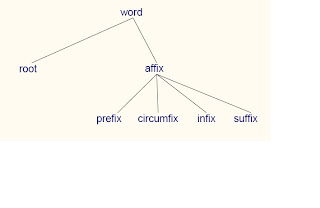allomorph = variant form of a morpheme (meaning same, sound can vary)
antonym = word pairs opposite in meaning
bahuvrihi or exocentric compounds = meaning can be guessed, AB is C (e.g. “laptop”)
circular definition = assumes a prior understanding of the term being defined
co-hyponym = e.g. „Sitzmöbel“ and „Ablagemöbel (under the hyperonym “Möbel”)
componential analysis = to analyze a word according to its semantic components [+/-]
compound = a word that consists of more than one element
Concordance = shows a word in the context of the text in which it is found (e.g. Google)
Corpus analysis = analysing words by doing concordances
database = organized collection of data
definition by nearest kind and specific differences = popular dictionary definition, e.g. “poodle” = “dog” (nearest kind) “with a haircut” (specific difference)
derivation = process of changing the meaning and/or lexical class of a lexeme by adding a morpheme (to only 1 root, otherwise it would be a compound)
determinants or modifier = in endocentric compounds:e.g. milkman (modifies the head)
determinatum or head = in endocentric compounds: e.g. milkman
dictionary = list of words with their definitions
document content = topics, objects, persons, events, …
document object = paragraphs, characters, lists, tables, graphics, …
document rendering = appearance/ layout
document structure = organized like a table, hierarchical and linear structure
dvandva or bicentric compounds = meaning is calculated according to the formula, AB is A and B (e.g. “whisky-soda”)
encyclopaedia = written compendium of knowledge
etymology = the origins of words
font = consists of a co-ordinated set of graphemes
generalisation = e.g. animal is a generalization of bird because every bird is an animal
grammatical morpheme or closed class morpheme or functional morpheme = mark syntagmatic relations of different kinds, within and between words. number is fixed
grapheme = the atomic unit in written language. Graphemes include letters, Chinese ideograms, numerals, punctuation marks, and other symbols.
hyperonym = a word whose extension includes the extension of the word of which it is a hyperonym
hyponym = a word whose extension is included within that of another word
inflection = modification or marking of a word so that it reflects grammatical information
inflection marker = free or bound morpheme that indicates the grammatical function of the marked word or sentence (e.g. the suffix -s in dogs is a plural marker)
IPA = International Phonetic Alphabet/Association
irregular inflection markers = may involve changes in the vowel and/or final consonant of the morpheme
KWIC concordance = Keyword In Context, most common concordance format
lemma = the canonical (authorized) form of a lexeme (z.B. der Stamm / Infinitiv eines Wortes oder einfach eine Nummer à der Lexikon-Eintrag, der sich am besten für das entsprechende Lexikon anbietet)
Level 1 Derivation or Stratum 1 = including stress-shift (e.g. celebrate à celebrity)
Level 2 Derivation or Stratum 2 = no stress-shift (e.g. happy à happiness)
lexical morpheme or open class morpheme or content morpheme = form the roots of simple words. new items can always be invented at any time.
lexicography = Practical lexicography is the art or craft of writing dictionaries. Theoretical lexicography is the scholarly discipline of analyzing and describing the semantic relationships within the lexicon (vocabulary) of a language.
meronomy = “part-whole-relationship” e.g. body (supraordinate) includes arms and legs (both subordinate)
meronym = see meronomy: arms and legs
morpheme = the smallest unit in a language which carries meaning
morphology = the study of the structure of word forms.
non-simplex word = including both derivations and compounds
opaque meaning = the meaning is not clear
orthography = set of symbols used to write a language, as well as the set of rules describing how to write these glyphs correctly, including spelling, punctuation, and capitalization
ostensive definition = “Definition by pointing” à conveys the meaning of a term by pointing out examples of what is defined by it
phoneme = the smallest unit in a language which distinguishes meaning
phonemic transcription = same as phonetic transcription
phonetic transcription = visual system of symbolization of the sounds in a language
phonology = describes the way sounds function
pragmatics = concerned with bridging the explanatory gap between sentence meaning and speaker’s meaning
prefix = an affix that precedes the morphemes to which it can attach
recursive definition = defines a word in terms of itself. has to avoid an infinite regress
regular inflection markers = suffixes attached to lexical morphemes
SAMPA = IPA written by computer keyboard (e.g. @ for schwa)
Sanskrit = a classical language of India
semantics = the study of meaning of (parts of) words, phrases, sentences, and texts
simple word = lexical morphemes form the roots of simple words
specialisation = e.g. bird is a specialization of animal because every bird is an animal
sublemma = subordinate dictionary entry?
suffix = an affix that follows the morphemes to which it can attach
superfix = e.g. produce (noun), produce (verb); (changing stress)
synonym = word pairs more or less same in meaning
syntagmatic relation = culturally determined pattern of association between pairs of lexical units
syntax = the study of the rules, or "patterned relations" that govern the way the words in a sentence come together
tatpurusa or endocentric compounds = 2nd part central item, AB is B (e.g. “milkman”)
taxonomy = the whole relation of hyperonyms and hyponyms etc.
thesaurus = a dictionary which lists words with similar, related, or opposite meanings
transparent meaning = the meaning is clear
word root = the core form of a word
zero affix = the word class changes but the orthography stays same (e.g. address)
zero derivation = the act of adding a zero affix




























